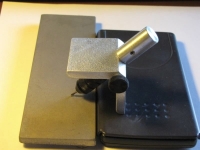The best way to sharpen small drills is to buy them by the dozen and discard the dull and broken ones.
Nevertheless, there's always the inevitable late Saturday shop session where you break your only #64 drill and you're dead in the water until you can order a new one on Monday. Then it's nice to have a way to touch up a buggered drill.
Here's an approach I use on those rare occasions. Its operation depends on the fact that, for very small drills, there is no need to try to make a conical point as found on larger drills. Simple flat facets that create the cutting edges are all that is needed. (In some senses, this jig embodies the same principle that gemstone diamond faceters use, albeit with only a single faceting angle.)
The device consists of a small pin vise fitted into a piece of aluminum angle.
The pin vise is free to rotate about its axis and, when properly oriented, can be locked in place with the small black plastic finger knob where the arms of the L meet. After mounting the drill in the pin vise collet, the pin vise is rotated to align the drill web with the line where the two arms of the L meet.
Then it's a simple matter of turning the assembly over and stroking the drill along a grinding stone as shown in the following photo...
The top of the angle should be horizontal so a spacer the same height as the grind stone is used. (At my desk, my calculator was handy. In the shop, a block of aluminum is used.)
Now to create the matching facet on the other side of the drill tip, it's a simple matter of flipping the fixture over and repeating the operation...
Inspect the tip with a loupe. If the facets aren't quite equal, a quick swipe or two will fix it. Since the drill to stone angles are preserved by the jig, you won't have multiple facets.
Credit where credit is due...
This jig was made by and given to me by Norm Wells, a very good friend. I'm not certain if the design is Norm's. I seem to remember seeing something similar in a magazine but I could be remembering diamond faceting tools.


 LinkBack URL
LinkBack URL About LinkBacks
About LinkBacks





 Reply With Quote
Reply With Quote





Bookmarks